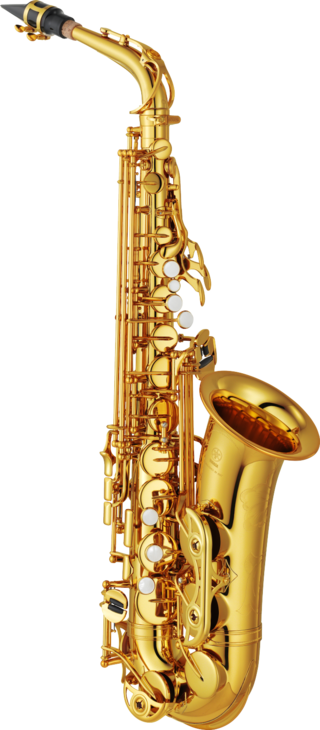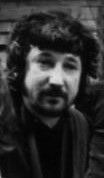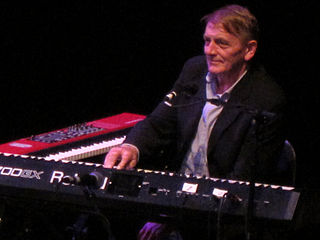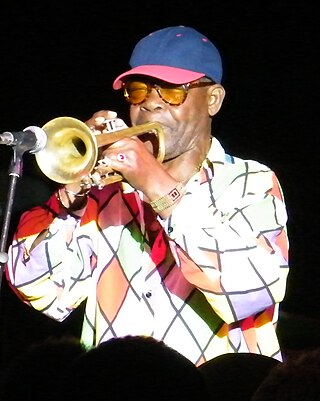
The saxophone is a type of single-reed woodwind instrument with a conical body, usually made of brass. As with all single-reed instruments, sound is produced when a reed on a mouthpiece vibrates to produce a sound wave inside the instrument's body. The pitch is controlled by opening and closing holes in the body to change the effective length of the tube. The holes are closed by leather pads attached to keys operated by the player. Saxophones are made in various sizes and are almost always treated as transposing instruments. Saxophone players are called saxophonists.

David James Mattacks is an English rock and folk drummer, best known for his work with British folk rock band Fairport Convention.

The alto saxophone is a member of the saxophone family of woodwind instruments. Saxophones were invented by Belgian instrument designer Adolphe Sax in the 1840s and patented in 1846. The alto saxophone is pitched in E♭, smaller than the B♭ tenor but larger than the B♭ soprano. It is the most common saxophone and is used in popular music, concert bands, chamber music, solo repertoire, military bands, marching bands, pep bands, and jazz.

The tenor saxophone is a medium-sized member of the saxophone family, a group of instruments invented by Adolphe Sax in the 1840s. The tenor and the alto are the two most commonly used saxophones. The tenor is pitched in the key of B♭ (while the alto is pitched in the key of E♭), and written as a transposing instrument in the treble clef, sounding an octave and a major second lower than the written pitch. Modern tenor saxophones which have a high F♯ key have a range from A♭2 to E5 (concert) and are therefore pitched one octave below the soprano saxophone. People who play the tenor saxophone are known as "tenor saxophonists", "tenor sax players", or "saxophonists".

The baritone saxophone is a member of the saxophone family of instruments, larger than the tenor saxophone, but smaller than the bass. It is the lowest-pitched saxophone in common use - the bass, contrabass and subcontrabass saxophones are relatively uncommon. Like all saxophones, it is a single-reed instrument. It is commonly used in concert bands, chamber music, military bands, big bands, and jazz combos. It can also be found in other ensembles such as rock bands and marching bands. Modern baritone saxophones are pitched in E♭.

The bass saxophone is one of the lowest-pitched members of the saxophone family—larger and lower than the more common baritone saxophone. It was likely the first type of saxophone built by Adolphe Sax, as first observed by Berlioz in 1842. It is a transposing instrument pitched in B♭, an octave below the tenor saxophone and a perfect fourth below the baritone saxophone. A bass saxophone in C, intended for orchestral use, was included in Adolphe Sax's patent, but few known examples were built. The bass saxophone is not a commonly used instrument, but it is heard on some 1920s jazz recordings, in free jazz, in saxophone choirs and sextets, and occasionally in concert bands and rock music.

Andrew Fairweather Low is a Welsh guitarist and singer. He was a founding member and lead singer of 1960s pop band Amen Corner, and in recent years has toured extensively with Roger Waters, Eric Clapton and Bill Wyman's Rhythm Kings.

Richard Edwin Morrissey was a British jazz musician and composer. He played the tenor saxophone, soprano saxophone and flute.

Georgie Auld was a jazz tenor saxophonist, clarinetist, and bandleader.

Otto James "Toby" Hardwicke was an American saxophone player associated with Duke Ellington.

Richie Cannata is an American music producer, saxophonist, keyboardist and studio owner. He is most notable for playing saxophone in Billy Joel's band alongside Liberty DeVitto, Russell Javors, and Doug Stegmeyer. After leaving the band in 1981, he opened Cove City Sound Studios in Glen Cove, New York. Artists including Celine Dion, Billy Joel, Jennifer Lopez and Marc Anthony have recorded in Cannata's studio. Cannata also worked with The Beach Boys for most of the 1990's, touring and occasionally recording with them during this period.
Robert George Downes is an English avant-garde jazz flautist and saxophonist. He is known for his work with Mike Westbrook and for leading the Open Music Trio since 1968. Downes is also a composer, arranger, and singer of rock and blues.

Geraint Meurig Vaughan Watkins is a Welsh singer, songwriter, rock and roll pianist and accordionist. He has backed many notable artists, including Nick Lowe, Dave Edmunds, Van Morrison, Mark Knopfler, Paul McCartney, Roy St. John, Shakin' Stevens and most recently Status Quo. He has also pursued a solo career and issued a number of albums under his own name, the most recent of which, Rush of Blood, was released in September 2019.
Donald Arthur Albert Weller was an English jazz musician, tenor saxophonist, and composer.

Georgie Fame and the Blue Flames were a British rhythm and blues group during the 1960s whose repertoire spanned R&B, pop, rock and jazz.
John David is a Welsh bassist and songwriter known equally for his work with Dave Edmunds and for his songwriting.

Edward Thornton, better known as "Tan Tan", is a Jamaican trumpeter, whose career began in the 1950s.

Norman Salant is a songwriter, saxophonist, composer and producer.

Derek Nash is a British jazz saxophonist, band leader and recording engineer.
La Booga Rooga was the second solo album by Andy Fairweather Low, and was released by A&M Records in 1975.















